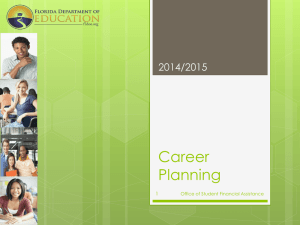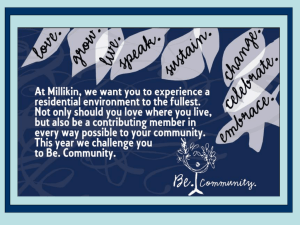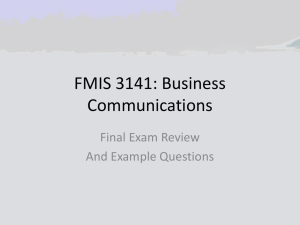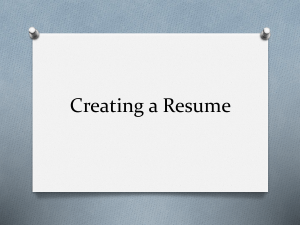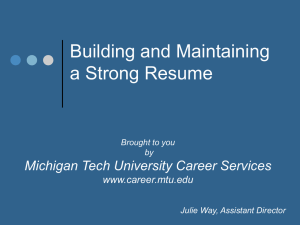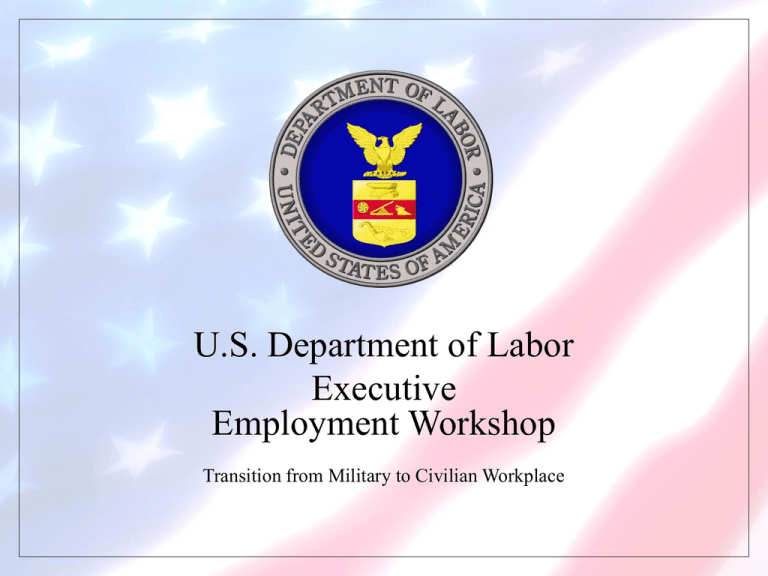
U.S. Department of Labor
Executive
Employment Workshop
Transition from Military to Civilian Workplace
Welcome
• Icebreaker
• Logistics
• Prerequisites
– Preseparation Counseling
– MOC Crosswalk
– Personal Finance
• Required items
– VMET, Career Interest Inventory Results, 12month budget
2
Key Points
• Attending this workshop will give you the advantage
• Good jobs are difficult to find
• Looking for work is a full time job
• You are selling and marketing yourself in a
competitive environment
3
Purpose
This course provides the tools for transitioning
Service members to make an informed career
decision based on best practices for job search
and current industry hiring standards.
This course is a required step to complete Career
Readiness Standards for the Capstone event.
4
Course Overview
Section 1:
Manage Change
Section 2: Career
Exploration &
Validation
Section 3: Job
Search Plan
Section 6: Skilled
Interview
Section 5:
Federal Hiring &
Resume
Section 4: Build
an Effective
Resume
Section 7:
Interview PostAnalysis
ITP Employment
Section
Thank you for
your Service!
5
Section 1
Transition planning
•
•
•
•
•
•
•
Complete Individual Transition Plan
Manage Change
Develop Job Search Plan: Personal Assets
Create a Career Catalog
Complete Master Application
Complete Transferable Skills Inventory
Identify Personal Factors for Job Search Plan
6
Identify Stressors
Cognitive Symptoms:
• Memory problems
• Inability to
concentrate
• Poor judgment
• Pessimistic approach
or thoughts
• Anxious or racing
thoughts
• Constant worrying
Physical Symptoms:
• Aches and pains
• Diarrhea or
constipation
• Nausea, dizziness
• Chest pain, rapid
heartbeat
• Loss of sex drive
• Frequent colds
7
Identify Stressors
Emotional Symptoms:
Behavioral Symptoms:
• Moodiness
• Eating more or less
• Irritability or short temper
• Sleeping too much or too little
• Agitation, inability to relax
• Isolating oneself from others
• Feeling overwhelmed
• Procrastinating or neglecting
responsibilities
• Sense of loneliness and
isolation
• Depression or general
unhappiness
• Using alcohol, cigarettes, or
drugs to relax
• Nervous habits (e.g. nail
biting, pacing)
8
Manage Stress
What are some positive ways to manage stress?
9
Homeless Veterans
2013 Statistics
• Annual veterans’ unemployment rate in 2012
was 7%.
– Young male veterans (those ages 18 to 24) who
served during Gulf War Era II had an
unemployment rate of 20%, higher than that of
young male nonveterans (16.4%).
– Female veterans who served during Gulf War Era II
had an unemployment rate of 12.5%.
Source: BLS 2013 Employment Situation of Veterans; www.VA.gov
10
Homeless Veterans
2013 Statistics
• On a single night in January 2013, 57,849
homeless veterans spent the night on the
streets of America.
• An estimated 136,128 veterans spent at
least one night in an emergency shelter or
transitional housing program in 2013.
Source: BLS 2013 Employment Situation of Veterans; www.VA.gov
11
Why Are Veterans Homeless?
• Male veterans are twice as likely to become homeless, and
female veterans are four times more likely to be homeless as
their non-veteran counterparts.
• A large number live with post traumatic stress disorders and
addictions acquired during or exacerbated by their military
service.
• Lack of family and social networks due to lengthy periods
away from their communities of origin.
• Government money is limited and serves only 1-in-5 of
homeless veterans in need.
12
Prevention of Homelessness
• Military service separation process
– Participate in “Preseparation” counseling process
– Participate in Department of Labor Employment Workshop
– Know about your VA Benefits
• Obtain a job and income
• Seek early assistance for mental health and substance abuse
issues
• DOL/VETS Homeless Veterans’ Reintegration Program (HVRP)
13
HVRP
Homeless Veteran Reintegration Program
Funded by U.S. DOL/VETS
This program provides employment, training,
and supportive services to assist in
reintegrating homeless veterans into
meaningful employment within the labor
force.
14
Decision Making
5-Step Decision Making Process
Step 1
• Develop Awareness About the Issue
Step 2
• Define the Problem
Step 3
• Generate Options
Step 4
• Evaluate & Select Options
Step 5
• Implement Options & Evaluate Progress
15
Identify Support System
List people who:
• You know and trust
• Can help you to connect with others
• Are accessible to you on an ongoing basis
• Have varied talents and abilities who can
provide assistance to you across a varied
spectrum of needs
16
Identify Support System
Josh
Nguyens
Garcias
Oginga
Jeremy
Jones
Softball
Team
Family
Neighbors
Support
System
Houghs
HS
Employer
Hudsacks
Nordquists
Mr.
Luigi
High
School
Rocco
Mrs.
Miller
Church
Pastor
Roberts
Mr.
White
Zane
Sgt.
Li
Military
Friends
Deena
Bucko
17
Manage Change
Or change will manage you.
Develop your own customized change
management plan.
Use your best resources and
knowledge.
Pages 4-13
18
Change Management Plan
Structures
Support
System
Life Goals
Skills
Stressors
Budget
19
Create a Career Catalog
In your career catalog you will have copies of:
• Records
• Master Application
• Work Samples, if applicable
Among the types of records you should collect in your
career catalog are:
•
•
•
•
Military Service
Personal Identification
Work Experience
Education & Training
Pages 14-15
20
Understand Your Skills
•
•
•
•
Build a master skills inventory
Use your VMET to identify skills.
Utilize MOC Crosswalk results.
Identify and list all of your skills gained
through: education, military service, previous
jobs, hobbies, interests, participation in
professional organizations and community
activities.
Pages 23-32
21
Marketing Plan (Personal Branding)
• Product – What skills, knowledge and experience do I have to
offer?
• Promotion – What will I use to show how I can benefit and
bring added value to an employer?
• Pricing – How much are my skills, knowledge, experience and
added value worth in the marketplace?
• Packaging – How can I use my Professional Introduction,
resume, interview, appearance, etc. to establish, maintain, and sell
my brand?
• Perfect Fit – What combination of location, environment,
company, values, etc. would be best for me and an employer?
22
Personal Assets
Assess and Evaluate:
–Skills
–CLAMS
–Values
–Preferences
Pages 33-42
23
Motivators
• CHALLENGE
• LOCATION
• ADVANCEMENT
• MONEY
• SECURITY
Page 33-36
24
Section 2
Career Validation & Exploration
•
•
•
•
Research Industries, Occupations, Trends
Identify Job Search Assistance Resources
Develop Job Search Plan: Essential Tools
Develop Job Search Plan: Target Employers
25
Job Search Assistance
•
•
•
•
•
•
•
•
•
•
•
State Workforce Agency (SWA) or One Stop Career Center
Workforce Investment Act (WIA)
Office of Apprenticeship (OA), U.S. Department of Labor
Private Employment Services
College/University/School Career Services
Military and Professional Associations and Organizations
Phone and/or Industry Directory
Industrial and Craft Unions
Job Fairs and Hiring Events
Chamber of Commerce
Military and Family Support Centers
Pages 46-49
26
Essential Job Search Tools
27
Target Employers
28
Informational Interview
The best way to get a job is to ask for job information,
advice, and referrals; never ask for a job.
•
•
•
•
•
•
Engage prospects in the 5 R’s of
Reveal useful information and advice
Refer you to others
Read your resume
Revise your resume
Remember you for future references & job
opportunities
29
Speak the
Employer’s Language
• Translating military to civilian is difficult but
necessary.
• Research the company and analyze the job
posting to decide what “language” an
employer speaks.
• Communicate the skills and experiences you
bring to the table—and what you can offer an
employer. Speak the employer’s language.
30
Business Concepts
Read
Business
Publications
Watch
Business
News
Join
Professional
Networking
Orgs
Attend
Courses
Mentor for
Business &
Profession
Accountability
Partner
Develop Understanding of Business Concepts
31
Professional Introduction
32
Section 3
Job Search Plan
•
•
•
•
•
•
Set Goals
Schedule
Network
Utilize Job Search Method
Analyze Job Postings
Complete Application Forms
33
Short-range, Medium-range
and Long-range Goals
Career Goal
Next Level
Entry
Level
Experience
Skills
Required
Education
Required
34
Setting Goals
SMART
GOAL
Trackable
Adaptable
Realistic
Measurable
Specific
35
Create a Schedule
Monday
Tuesday
Wednesday
Thursday
Friday
8-10
8-10
8-10
8-10
8-10
Review Job
Postings
Research
Companies
Review Job
Postings
Interview
Review past
week
10-12
10-12
10-12
10-12
10-12
Target Resumes
Practice
Answering
Questions
Play Golf
(network)
Send Thank
you, Analysis
Review Skills,
add more
12-1
12-1
12-1
12-1
12-1
Lunch
Lunch
Lunch
Lunch
Lunch
1-4
1-4
1-4
1-4
1-4
Complete online
application,
Calls
Interview,
Network event
Send Thank you,
Analyze
Interview
Twitter,
LinkedIn,
Facebook
Target Resumes
4-5
4-5
4-5
4-5
4-5
Plan for
tomorrow
Plan for the
week
Cook Dinner
with Friends
Walk
Clean Office
36
How Job Seekers
Look for Jobs
Average number of methods used: 2.03
Source: Bureau of Labor Statistics
37
How Employers Look
for Employees
Source: Bureau Labor Statistics
38
Job Search Plan
Network
Online
Effort
Organize
In
Person
Schedule
Focus
Target
Employers
Resume
39
Analyzing Job Postings
Job postings provide information about the
types of positions available, the skills required
and the language an employer speaks.
Analyze postings for:
– Experience needed
– Qualifications
– Salary
– Skills
Page 93
40
Application Forms
•
•
•
•
Read the directions
Fill out application forms completely
Utilize your master application
Safeguard your right to privacy
Pages 94-96
41
Section 4
Effective Resume
•
•
•
•
•
•
•
•
•
Understand the Resume Reader
Target Resumes and Master Resume
Sections of a Resume
Prepare References
Resume Types
Resume Formatting
Resume Review
Cover Letter
Salary History
42
Section 4
Effective Resume
Resume Screening Process
100
Scanned
20
Reviewed
5-10
Called
Interview
43
Section 4
Career & Job
Positions
Resume
Type
-Chronological
-Functional
-Combination
-CV
Step Three
Identify
Step Two
Step One
Effective Resume
Customize
Master
Resume
with
Keywords
44
Sections of a Resume
1.
2.
3.
4.
5.
6.
7.
Contact Information
Career/Job Objective Statement
Summary
Areas of Expertise
Experience
Employment History
Education/Training
45
Contact Information
Make sure your information is current and
accurate:
Lynn Gweeney
234 Brook Avenue, Englewood, Colorado 12345
(123) 456-7890
Lynn.Gweeney@email.com
Page 117
46
Career/Job
Objective Statement
Well-written career objectives are
• Concise, short and to the point
• Answer the question “For which position are
you applying?”
• List the specific job and company to which you
are applying
Pages 118-119
47
Summary
A short paragraph used to highlight key words
and marketable skills/experience, and recaps
what you can offer, including:
• Specific knowledge, talent or education that
“ties” you to your career interest
• Self-management skills
• Work attributes
• Soft skills
Pages 120-121
48
Area of Expertise
A list of bullet points which provide a sense of
what you can do for the company:
• Highlight key skills that support job goal
• Match key words in job announcement
• Include certifications/licenses required
• List security clearance if relevant for position
Pages 121-123
49
Tailor and Target
• Use “Personal Branding” approach to craft
Executive Summary
• Keywords (company and industry specific)
• Soft skills vs. Hard skills
• Executive Resume samples
– Professional Summary, Professional Overview,
Executive Summary
• STAR statements
50
Experience
• Use civilian terms. Speak the employer’s
language. Use key words
• Begin with an action verb
• Avoid “Responsible for”
• Quantify results: use numbers, percentages,
statistics and examples
• Avoid personal pronouns (I, me, my…)
• Wordsmith your statements
Pages 125-134
51
STAR Statements
• Accomplishments sell your potential; lead
with results
• For Example
– Managed and maintained logistical resources in excess of
$15 million over 43 geographically separate locations
producing a savings of 28% annually.
– Spearheaded one-of-a-kind action team to control outside
costs; resulted in 17% cost reduction in radiology and 26%
cost reduction in physical therapy in 1 year.
– Developed a robust training curriculum; implemented,
trained and evaluated training given to 200 personnel
annually …(Complete this statement)
52
Education and Training
• List most recent first
• Put “attended” if you never graduated to
prevent the assumption that you have a degree
• Include certifications/licenses/training relevant
to job
• Depending on your background and the job for
which you’re applying, Education & Training
might be placed above Experience or
Employment History on your resume.
Page 136
53
Review
• Resumes
– Speak for you when you’re not there
– Serve as a marketing tool
– Must highlight your ability to do the job
– Should lead to an interview
• Resumes are a work in progress
54
Section 4
Resume Lab
Choose:
– Style
– Formatting
Draft:
– Sections
– Content in sections
– Focus on STAR accomplishment statements
Save Master Resume File:
If using computer lab, email file to yourself
55
Cover Letters
Introduce yourself and sell the employer on how
well your specific skills, abilities and attributes
match the organization’s needs.
Four main components:
1.
2.
3.
4.
Introduction
Relevant Reason for Cover Letter
Request for Action
Respectful Sign Off
Pages 151-153
56
Section 5
Federal Resume
•
•
•
•
•
•
Federal Hiring Reform
Job Classification
Competitive Service
Veterans’ Preference
Excepted Service
Special Hiring Authorities for
Veterans
•
•
•
•
•
•
•
Veterans Employment Initiative
Finding Jobs
Understanding the Vacancy
Announcement
Application Procedures
Federal Interviewing
Getting the Offer
57
Federal Jobs
•
•
•
•
•
Classifications
Veterans’ Preference
Selection Processes
Find jobs
Apply for jobs
58
Senior Executive Service
(SES)
• Managerial, Supervisory, Policy positions
classified above GS 15
• Scientific and Professional (ST), Senior Level
(SL), Appointments, Presidential/Senate
Confirmation
• Executive Core Qualifications (ECQs)
– Leading Change, Leading People, Results Driven,
Business Acumen, Building Coalitions
• Qualifications Review Boards
59
Federal Jobs
60
Section 6
Skilled Interview
•Summary of the Hire Process
•Types of Interviews
•Interview Stages
•Introductory Stage
•Employer Questions
•Answer Questions
•Candidate Questions
•Closing Stage
•Prepare for the Actual Interview
•Communication in the Workplace
•Listening Skills
•Employment Tests
•Find Information about a Potential
Employer
•Interpret Body Language
•First Impressions
•Follow-Up After Interview
61
Skilled Interview
Hiring Process
First
Contact
Phone
Interview
Face-toFace
Interview
Tests
Reference
Checks
Background
Checks
Offer &
Negotiation
62
Types of Interviews
• Face-to-Face
• Panel or Committee
• Meal Interview
• Group
• Stress
• Phone
Page 187-189
63
Skilled Interview
Interview Stages
Building
Rapport
Employer
Questions
Candidate
Questions
Closing
• Introduction
• Company
History
• Info about
the position
• Behavioral
• Contextual
• Resume
based
• STAR
method
• Appropriate
Questions
• Follow-up
• Ask for the
job
• Thank you
64
Mock Interview
• Practice makes permanent
• Practice to make it skilled
• Take notes
65
Prepare for Interview
•
•
•
•
Research
Checklists
Questions
References
66
Dress for Interview
67
Follow-up
The art of
thank you!
68
Section 7
Interview Post Analysis
•
•
•
•
Evaluate the Interview—Continuous Improvement
Evaluate Job Offers
Negotiate Job Offers
Communicate a Decision to an Employer
69
Understanding Salary
Ranges
Job Salary Range
Midpoint or Market Value
Beginner Range
Experienced Range
Highly Qualified Range
$90K - $120K
$100K
$90K - $95K
$95K - $115K
$115K - $120K
Salary Negotiation
Best Time to Negotiate
Offer accepted!
You’re our candidate!
You’re in the running!
You might be a fit
Too
Early
FO&D
Who are you?
Too
Late
Offer
Extended
Negotiation Items
•
•
•
•
•
Vacation/Sick Leave
Flexible Work Hours
Health/Life/Disability
Education Assistance
Flexible Spending
Accounts
• Stock Options
•
•
•
•
Transportation
Credit Card
Signing bonus
Uniforms
Update ITP
•
•
•
•
Next steps
SMART Goals
Schedule
Additional education, certification,
skills
73
Course Summary
•
•
•
•
•
•
•
Manage Change
Personal Assets
Career Validation
Resume
Federal Job Search
Skilled Interview
Interview Post-analysis
74
Wrap-up
• Expectations Met
• Evaluations
– https://www.dmdc.osd.mil/tgpsp
• Comments
• What questions do you have?
75


